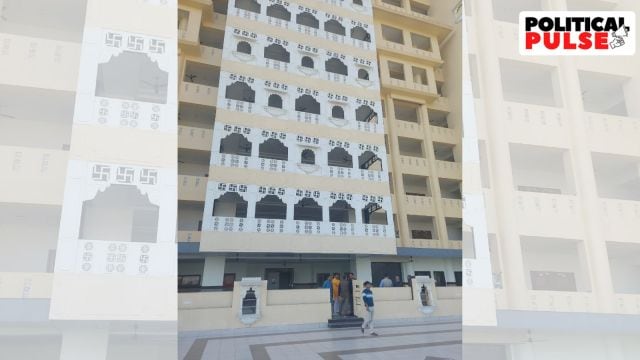RSS gets new swanky Delhi headquarters — built at Rs 150 crore with three towers, 300 rooms, auditoriums
According to the RSS, Keshav Kunj is spread over four acres. In terms of size, it eclipses BJP's national headquarters.
 The three new towers of the RSS headquarters – named “Sadhana”, “Prerana”, and “Archana” – encompass 300 rooms and office spaces apart from several conference halls and auditoriums. (Express Photo)
The three new towers of the RSS headquarters – named “Sadhana”, “Prerana”, and “Archana” – encompass 300 rooms and office spaces apart from several conference halls and auditoriums. (Express Photo)Three 12-storied towers with a built-up area of 5 lakh square feet, a parking space for 270 cars, three state-of-the-art auditoriums with a seating capacity of over 1,300 people, a library with specially designed cubicles for research, a five-bed hospital, manicured lawns, and a Hanuman temple where earthen diyas have given way to electric lamps. These are some of the key features of Keshav Kunj, the newly built headquarters of the Rashtriya Swayamsevak Sangh (RSS), at Jhandewala in Delhi, where the organisation fully shifted Wednesday.
According to the RSS, Keshav Kunj is spread over four acres and built at a cost of Rs 150 crore. In terms of size, it eclipses the BJP headquarters at Deen Dayal Upadhyay Marg and has five lakh square feet of space for office and residential purposes, and other activities of the Sangh.
An RSS functionary said the Keshav Kunj has been entirely built from donations of RSS workers and those associated with the Sangh. “As many as 75,000 people have donated anything between Rs 5 to several lakhs of rupees to help build the headquarters,” the functionary said.
The new RSS headquarters has been designed by Gujarat-based architect Anup Dave who, sources said, has earlier been associated with projects of the Gujarat government. The builder involved in the project is Delhi-based Auspicious Constructions, which largely builds malls, business complexes, and parking complexes in the national capital. The firm has, however, also been associated with the construction of buildings of the Sangh in the past, such as the Vishva Hindu Parishad (VHP)’s Dharma Yatra Maha Sangh building on Deen Dayal Upadhyay Marg, and other Hindu religious structures like Shree Jagannath Sewa Sangh building in Rohini, and the Sanatan Bhawan in Ashok Vihar.
For the past eight years, the RSS had been functioning out of the Udaseen Ashram in Jhandewala, which it had rented to allow for the new construction of its headquarters.
Sources said the Sangh functionaries began shifting to the new building gradually from September last year and have now completely vacated the Udaseen Ashram office, even though work on interiors in some parts of the new headquarters is still on.
#WATCH | Delhi | The new headquarters of the Rashtriya Swayamsevak Sangh (RSS), ‘Keshav Kunj,’ has been completed in Delhi. The RSS has shifted its office back to its old address in the city. The reconstruction project spans 3.75 acres and consists of three 12-story buildings,… pic.twitter.com/vOkojE4FGE
— ANI (@ANI) February 12, 2025
“Delhi was the third place where RSS established its offices after Nagpur and Madhya Pradesh. Our first office here was opened in 1939, a short distance away from the present headquarters. In 1962, a one-storey office took shape right here and in the 1980s another storey was added. The office had remained so until 2016, when the Keshav Kunj project was launched,” an RSS functionary said.
The three new towers of the RSS headquarters – named “Sadhana”, “Prerana”, and “Archana” – encompass 300 rooms and office spaces apart from several conference halls and auditoriums. Sadhana houses all the offices of the RSS, while Prerana and Archana are residential complexes.
Between the Prerana and Archana towers is a large open space with a manicured lawn and the statue of RSS founder Keshav Baliram Hedgewar. According to the Sangh, the space has been set aside to hold daily shakhas. The complex also has parking space which could currently accommodate 135 cars with its capacity to be upgraded to 270 in due course.
There are three large auditoriums with a cumulative capacity of over 1,300 people. One of the auditoriums, which features stadium seating and cushioned sofa seats, has been named after former VHP president and key Ram Temple movement leader Ashok Singhal.
The windows of the building have been adorned with facades that, Sangh sources said, are inspired from traditional architecture in Rajasthan and Gujarat. They said the building has used 1,000 granite frames to save on wood.
“The entire complex has been built in a way that it gets enough light and air. The solar panels installed on the roof will meet 20 per cent of the power consumption needs of the building. There is also a sewage treatment plant with enough capacity to treat all the sewage produced by the headquarters. We will thus be releasing zero sewage into the city’s drains,” a senior RSS functionary said.
The new RSS headquarters also boasts a five-bed hospital to provide medical aid to ailing karyakartas and a dispensary, which is open to the public.
On February 19, RSS chief Mohan Bhagwat will hold Karyakarta Milan at the new headquarters. Following this, the Akhil Bharatiya Pratinidhi Sabha Baithak will be held during March 21-23 in Bengaluru.



- 01
- 02
- 03
- 04
- 05




























